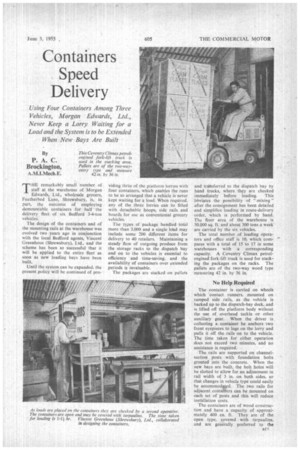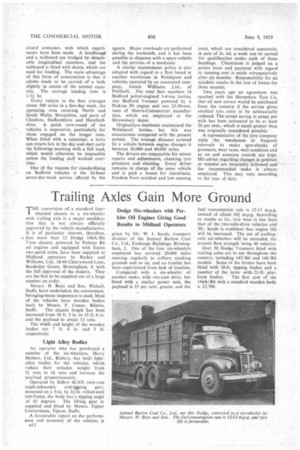Containers Speed Delivery
Page 45

Page 46

If you've noticed an error in this article please click here to report it so we can fix it.
Using Four Containers Among Three Vehicles, Morgan Edwards, Ltd., Never Keep a Lorry Waiting for a Load and the System is to be Extended
When New Bays Are Built
• By
P. A. C. Brockington,
THE remarkably small number of staff at the warehouse of Morgan Edwards, Ltd., wholesale grocers, Featherbed Lane, Shrewsbury, is, in part, the outcome of employing demountable containers for half the delivery fleet of six Bedford 3-4-ton vehicles.
The design of the containers and of the mounting rails at the warehouse was evolved two years ago in conjunction with the local Bedford agents, Vincent Greenhous (Shrewsbury), Ltd.. and the scheme has been so successful that it will be applied to the entire fleet as soon as new loading bays have been built.
Until the system can be expanded. the present policy will be continued of pro viding three of the platform lorries with four containers, which enables the runs to be so arranged that a vehicle is never kept waiting for a load. When required, any of the three lorries can be fitted with detachable hoops, side rails and boards for use as conventional grocery vehicles.
The types of package handled total more than 3,000 and a single 'dad may include some 200 different items for delivery to 40 retailers. Maintaining a steady flow of outgoing produce from the storage racks to the dispatch bay and on to the vehicles is essential to efficiency and time-saving, and the availability of containers over extended periods is invaluable.
The packages are stacked on pallets
and transferred to the dispatch bay by hand trucks, where they are checked immediately before loading. This bbviates the possibility of " mixing " after the consignment has been detailed and simplifies loading in route-delivery order, which is performed by hand. The floor area of the warehouse is 30.000 sq. ft. and about 300 tons a week are carried by the six vehicles.
The total number of loading operators and office staff is 10, which compares with a total of 15 to 17 in some warehouses with a corresponding capacity. A Coventry Climax petrolengined fork-lift truck is used for stacking the packages on the racks. The pallets are of the two-way wood type measuring 42 in. by 36 in.
No Help Required
The container is carried on wheels which contact runners, mounted on ramped side rails, as the vehicle is backed up to the dispatch-bay deck, and is lifted off the platform body without the use of overhead tackle or other auxiliary gear. When the driver is collecting a container he anchors two front eyepieces to lugs on the lorry and pulls it off the rails on to the vehicle. The time taken for either operation does not exceed two minutes, and no assistance is required.
The rails are supported on channelsection posts with foundation bolts grouted into the concrete. When the new bays are built, the bolt holes will be slotted to allow for an adjustment in rail width of 3 in. on both sides, so that changes in vehicle type could easily be accommodued. The two rails for adjacent containers can be mounted on each set of posts and this will reduce installation costs.
The containers are of wood construction and have a capacity of approximately 400 cu. ft. They are of the open type, covered with tarpaulins, and are generally preferred to the
closed container, with which experiments have been made. A headboax.d and a tailboard are bridged by detachable longitudinal members, and the tailboard is fitted with doors, which are used for loading. The main advantage of this form of construction is that it allows loads to be carried of a bulk slightly in excess of the normal capacity. The average loading time is 1-14 hr.
Every vehicle in the fleet averages about 500 miles in a five-day week, the operating area covering North and South Wales, Shropshire, and parts of Cheshire, Staffordshire and Herefordshire. A quick turn-round of the vehicles is imperative, particularly for those engaged on the longer runs. When fitted with a container, a lorry can return late in the day and start early the following morning with a full load, which would otherwise be impossible unless the loading staff worked overtime.
One of the reasons for standardizing on Bedford vehicles is the 24-hour seven-day-week service offered by the agents. Major overhauls are performed during the weekends, and it has been possible to dispense with a spare vehicle and the services of a mechanic.
A similar maintenance policy is also adopted with regard to a fleet based at another warehouse in Welshpool and vehicles operated by an associated company, Josiah Williams, Ltd., of Pwllhelli. The total fleet numbers 14 Bedford petrol-engined 3-4-ton lorries, one Bedford 5-tanner powered by a Perkins P6 engine and two 23-30-cwt. vans of Morris-Commercial manufacture, which are employed at the Shrewsbury depot.
Originally a mechanic maintained the Welshpool lorries, but this was uneconomic compared with the present system. The average distance covered by a vehicle between engine changes is between 50,000and 60,000 miles.
The drivers arc responsible for minor repairs and adjustments, checking tyre pressures and cleaning. Every driver remains in charge of the same vehicle and is paid a bonusfor cleanliness, freedom from accident and low running
costs, which are considered separately. A sum of 2s. 6d. a week can be earned for qualification under each of these headings. Cleanliness is judged on a points basis and payment with regard to running cost is made retrospectively after six months. Responsibility for an accident results in the loss of bonus for three months.
Two years ago an agreement was reached with the Shropshire Tyre Co. that all new covers would be purchased from the concern if the service given enabled tyre, costs to be substantially reduced. The actual saving in pence per mile has been estimated to be at least 20 per cent., which is much greater than was originally considered possible.
A representative of the tyre company visits the warehouse at frequent intervals to make spot-checks of pressures, wear rates, wall condition and so on and accurate records are kept. His advice regarding changes in position or renewal -are invariably followed and the recommended make is always employed. This may vary according to the type of duty.




































































































